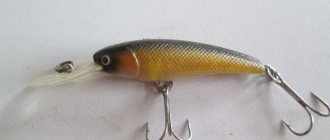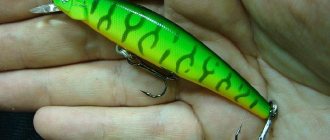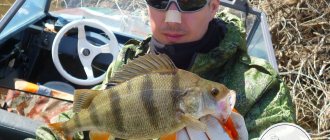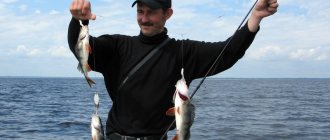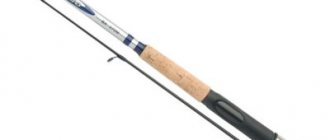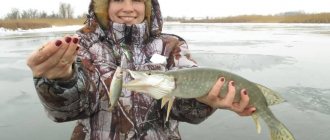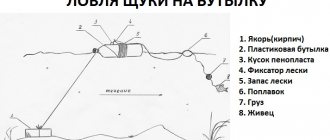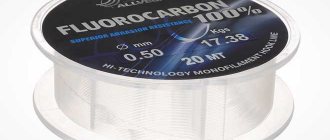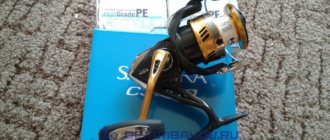Optimal spinning rod for perch
Beginner fishermen want to get the optimal spinning rod for catching striped predators. A universal whip for a beginner with technical indicators is:
- The rod weighs up to 10 grams, no more.
- It is better to take ultralight, which can be used to feed bait weighing 2–15 grams.
- The upper dough limit is from 7 to 10 g.
- Fast or medium-fast action is suitable.
- The length of the stick is from 180 to 240 cm. It all depends on the chosen hunting location: shore or boat.
- As for the coil. It should be light, up to 0.2 kg. On the spool you need to place a fishing line with a diameter of up to 0.2 mm, or a cord of 0.1-0.12 mm. Therefore, the spool capacity according to the Shiman classification is 1–2 thousand.
We can say that this is the optimal spinning rod for perch. But there are a number of other nuances that we will reveal as the publication progresses. Possessing a spinning rod with the specified parameters, a novice minke whale hunter will not have much difficulty in catching his first trophy.
We choose a spinning rod for catching pike and perch. Tips for beginners
How to choose a good inexpensive spinning rod for catching pike and perch.
Spinning fishing is very different from quiet, peaceful gatherings with a float rod on the river bank or on the current in an anchored boat.
Spinning is a fishing rod designed specifically for catching pike, pike-perch, perch or other predatory fish. It is not used to catch small fish, although it can be used to catch some omnivorous large fish. A float is never used with it.
Let's figure out how to catch pike with a spinning rod.
First of all, you need to estimate the weight of possible prey. There are several classes of spinning rods, differing in the test of the rod and fishing line. The spinning rod test is the weight of the bait for which it is designed. There is also such a thing as a fishing line test.
It is marked on the rod with either two Latin letters CW or the word tect. A range is indicated next to it, for example, 5-20. This is the weight of the bait in grams. It is optimal to use a bait of medium weight, in this case about 12 g. It is undesirable to be too light - it will be inconvenient to cast. It is not allowed to be too heavy - large fish will bite on large bait, and the rod may break when fishing.
The fishing line test is indicated next to it, test line in English. It is calculated by the manufacturer empirically and means the load at which the line will burst before the rod breaks.
The test line is measured either in kilograms or in British pounds (marked as lb). One pound = 0.46 kg. Accordingly, if a line value of 8-17 lb is specified, this is converted to the metric system as 8*0.46=3.7, and 17*0.46=7.8. Choose a fishing line with a tension from 3.7 to 7.8 kg, optimally in the middle range.
The best spinning rods for pike fishing should correspond to one of three classes (also often marked on the rod):
L - for small fish, bait weighing 8-10 g, tensile strength of the line - maximum 4.25 kg, diameter - 0.2 mm; M - for medium fish, bait 18-21 g, line test - maximum 6 kg, section diameter 0.25 mm; H - for large fish, bait maximum 42 g, fishing line test - 12 kg with a diameter of 0.4 mm. Roughly speaking, the line test refers to the size of the fish that can be caught. In most cases, a middle-class spinning rod - M, “medium” – is sufficient. In our rivers and lakes, pike weighing more than 5-6 kg are very rarely found. When choosing a spinning rod for small grass pike, L - “light” is quite enough. Tackle of class H - “hard” is redundant in our realities, in addition, such spinning rods are very heavy, and you will quickly get tired of swinging them.
The choice of a spinning rod for pike fishing should be based primarily on an understanding of the size of the fish you are going to actively catch.
When choosing from spinning rods for pike fishing based on material, decide in advance on your fishing tactics. For active casting, carbon fiber gear is best suited; it is light but durable. Fiberglass ones are heavier and are good for trolling tactics, as are the newfangled Kevlar ones. To choose the right spinning rod for pike or perch, you also need to take into account the so-called rod structure. This is what fishermen call the bending parameter of a fishing rod - a rigid or fast action tackle begins to bend only at the tip, in the upper third of its length. Medium - the bending point is in the middle, slow or soft action - the rod bends almost from the very base, from the handle.
The structure is also very important to consider when selecting bait and fishing tactics. Active fishing with fast hooks requires a sensitive tool with a fast action, and only this is suitable for heavy baits. Simply put, the tighter the action, the more sensitive the entire tackle. Easier to hook, harder to fish out. With a slow formation, it’s the other way around - fishing can be very convenient, because The elasticity of the rod absorbs the jerks of the predator, but it’s difficult to hook quickly. But this tackle is well suited for catching pike. The best spinning rods for catching zander, perch or pike are medium.
Spinning for beginners should be of medium action, this is the best option. When you decide on your favorite tactics, you can choose gear according to your fishing style.
After purchase, it still needs to be properly prepared and equipped. You are going to catch a predator, careful, cunning, adapted by nature itself to survive. Fishing for pike and perch can only be successful if you know how to rig, configure and equip a spinning rod. There are no trifles in this matter - everything is important.
The spinning rod equipment for any pike includes:
coil; fishing line; leash; sinker; a hook for live bait or vibrotail, or a wobbler or other ready-made artificial bait with hooks. There are several main types of spinning equipment for fishing - basic, at least two varieties of American and Russian, bombard, drop-shot and others. They mainly differ in the way the leash is attached and the type of sinker - “Cheburashka”, olive or bullet and others. Some types of equipment on a conventional pike spinning rod are designed for fishing with ultra-light or, conversely, extra-heavy bait. We will describe the basic, most optimal and convenient option.
When choosing a reel for a spinning rod, choose a spinning reel, preferably one with a good brake. It is necessary that it ensures good quality of line laying.
There are two types of fishing line for spinning - monofilament, made of one thread, and braided. To the question of which fishing line is better, the clear answer is braided. Braided fishing line is better because it practically does not stretch; with the same thickness as monofilament, it is stronger; with the same strength, it is thinner, and therefore less noticeable in the water. But braided spinning rod is 3-4 times more expensive than monofilament, and is also more difficult to wind evenly. When fishing, the fact that the braided cord hardly stretches can be affected - some fishermen consider this to be an inconvenience.
Optimally - 150 m, less is not enough, and more is a lot; a long braided cord does not wrap well on the spool of a spinning reel.
It is better if the color of the cord does not stand out in the water.
Pike fishing gear must include a leash. He can be:
Kevlar; steel; titanium; with tungsten filament.
For catching pike with a spinning rod, a leash is absolutely necessary, because... She easily bites through any fishing line. You will also need it to catch perch with a spinning rod. The color doesn’t really matter; a leash chosen in a store or one made with your own hands from a guitar string will perform equally well. The most important thing in a purchased product is the carbine or swivel with which it is equipped. A budget leash equipped with a poor, soft carabiner will let you down when the metal of the carabiner bends under the weight of the fish.
Advice! When fishing with an oscillating vibrating tail or other “playing” bait, you need to make the leash lighter so that its mass does not spoil the “game”.
The equipment of spinning rods for river or lake pike necessarily includes sinkers, baits and hooks, but with them it is more difficult. It all depends on the nozzle. If using live bait or spoons, sinkers are necessary, but not with heavy artificial baits. Everything is individual.
Prepare the assembled spinning rod in advance.
Features of pike fishing, or how to catch pike correctly
There are no trifles in this matter. The key to successful pike fishing with a spinning rod consists of:
Choosing a place. Choice of gear. Choice of bait.
Fishing with a spinning rod from the shore requires a competent choice of location. Pike are ambush predators, they like to hide in snags at the bottom, sometimes they lie in wait for prey at the exit of sedge or cattail thickets, they like quiet water with a gentle current. They usually avoid rapids. Young bee-eaters, the so-called grassworts, often hide in reeds or other algae; large adult specimens go to the bottom, from where they rise to attack.
Fishing for this fish is optimal either from a boat at great depths, or from a steep bank, under which there is a hole, a pool or thickets of aquatic grass. You need to set up a hiding spot there.
The best bait for a predator is live bait, a small fish like bleak or roach. If it is not there, you can use artificial bait.
For spinning for pike the following are used:
oscillating spoons (oscillators); wobblers and poppers - bait in the form of artificial fish with one or two double and triple hooks; twisters and vibrotails - completely soft, made of silicone, or soft artificial fish with a hard insert; spinners; spinnerbaits.
Fishing for pike using a spinning rod using a frog can also be used. The required type of bait is selected strictly at the fishing site.
Each type of bait implies its own tactics of use. There is no clear answer to the question of how to properly lure a pike. The correct placement of a spinner or wobbler can also vary depending on the fishing tactics - whether it is active jigging or rather lazy trolling. Beginners are recommended to use a slow or lazy retrieve for pike; experienced fishermen can try stepped or twitching.
How to fish with a spinning rod? The angler makes a cast, waits for the bait to sink sufficiently, and then begins to play, sometimes tightening and then loosening the line. Fishing with a spinning rod on the river is interesting because it is enough to tighten the line, and then give it slack again - the current itself will straighten it, you don’t need to make many repeated casts.
When fishing with a spoon or other bait, regardless of this, the hook should be sharp and strong. The predator needs to be weakened, so when fishing, several hooks are made. The predator, hooked and picked up with a landing net, is placed in the cage as quickly as possible; a special tool may be required to remove the nozzle.
You need to collect equipment depending on the time and place - for example, in the summer surface baits (wobblers) work well, in the fall deep baits (spinners), and in the thickets only spinnerbaits are used.
At what times of the year is it best caught? Any. Only autumn fish often go into the depths; in summer they stay in shallow water, where their prey feeds; in spring they prefer changes in depth - places near pools and holes.
Read other articles, reviews and testimonials:
- Review of Nories spoons. How to spot a fake Nories Rooney.
- Review of travel spinning rod for travel Volzhanka Voyage
- Review of the Strike Pro Montero 90SP, 110SP and 130SP wobbler. Reviews from anglers about the wobbler Strike Pro Montero 110 and 130 SP
- Review of the Salmo Hornet wobbler. Anglers' reviews of the Salmo Hornet wobbler
- Mormyshing on a spinning rod. How to fish with a jig using a spinning rod
How to choose a spinning rod for perch according to parameters
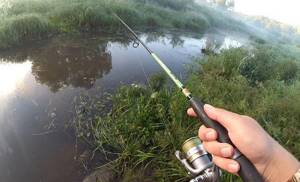
When choosing a spinning rod, you need to take into account its parameters, which include:
- test;
- rod length;
- system;
- material of manufacture;
- whip design.
When choosing a rod for catching striped prankster, you need to know and remember that all spinning rods are conventionally divided into 3 classes with a certain test, such as:
- Light class poles. The test ranges from 2 to 15 grams.
- Middle class rods with test values from 10 to 30 g.
- Heavy artillery third class. The test starts from 30 grams and above.
Let's take a closer look at what a test is and how it affects fishing?
Spinning rod classes
All spinning rods are divided into classes:
- ultralight (light), its test range is from 0.2 to 15 g;
- average from 15 to 30 g;
- heavier class from 30 g and above.
What is a test?
The spinning test is indicated on each rod or spinning rod. It looks like numbers, for example test 0.3 - 12 g. This means that the tackle is intended for a wobbler, silicone or spinner of the specified weight.
What is a system?
Action is the flexibility of a rod. For perch fishing, it is better to choose the most flexible spinning rod. The softer it is, the more sensitive the bite will be. They are divided into 4 systems:
- Extra fast. The rod is very rigid, only the tip itself bends.
- Fast. The rod is rigid, weakly bends and very sensitive, but it is not capable of long casting, but it has high casting accuracy.
- Medium tuning bends to the middle.
- Small action (slow) makes the longest cast, but has low sensitivity and is not very accurate.
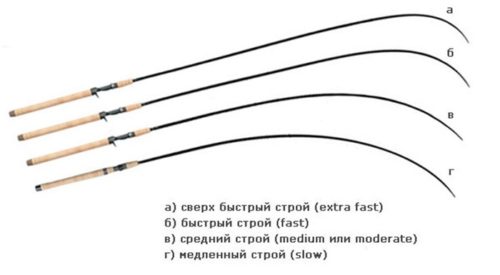
The choice depends on the type of reservoir where perch fishing will take place.
What to look for when purchasing
When choosing a spinning rod, you should not save money. It’s better to buy a branded item once that will last for years than to change equipment or buy a new fishing rod every fishing trip.
Points worth paying attention to:
- It should not crunch when bent; this indicates microcracks.
- A light spinning rod for perch would be an excellent option.
- All rings must be securely glued.
- The reel mount must be metal and not soft.
- The handle and holder should be very comfortable and soft in your hands. After all, sometimes you have to walk with a spinning rod for more than one hour.
- The threads at the end of the handle on the lid and on the reel should not be torn off; this is definitely worth checking.
- There should be no scratches or nicks on the spinning rod itself.
You need to pay attention to all suspicious points and ask questions to the seller.
How to choose a spinning rod for perch for beginners
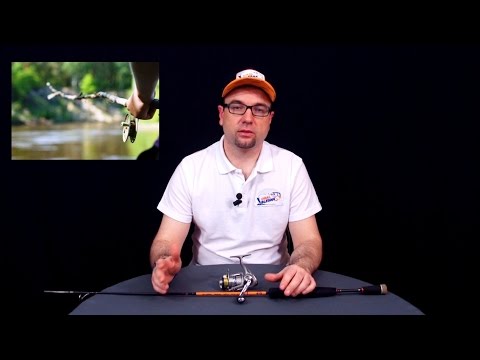
Spinning test for perch and its effect on fishing
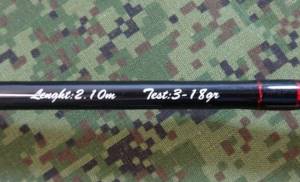
In the previous segment, we already told you what a spinning rod test for perch can be. Now let's find out its role when hunting for a predator. Individual specimens of perch can exceed 1 kg. But this is rather an exception to the rule. The majority of minke whales weigh 300–500 grams. Therefore, the spinning rod should be light or ultra-light class.
If you put a bait, say 25 grams, on a rod with a weight of 2–10 grams, you won’t be able to cast it far. In addition, the wiring will be ineffective. Playing bait will not attract a predator: hunting for perch will not bring the desired result.
Spinning test
A test is the amount of bait available for spinning, usually consisting of the minimum and maximum available indicator. Most often, the test size is indicated directly on the rod.
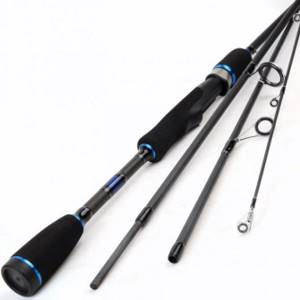
A spinning rod for catching perch must have an ultralight class test, and the range of baits available to it must not exceed 10 grams. Lures from 7 grams are used.
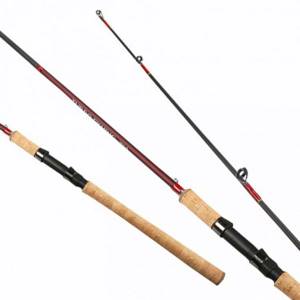
Rod build
When choosing a fishing rod, you need to take into account its structure, in other words, flexibility.
- Fast build. Only the tip of this rod bends. The rod is very tough.
- Medium build. This rod can be bent to the middle of the blank.
- Slow build. The rod is soft and bends almost to the handle.
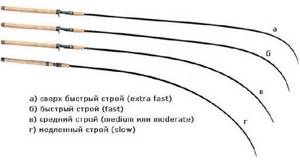
Each option has its positive and negative aspects. For example, fast-action sticks allow you to perform precise casting and at the same time have high sensitivity. Of the main disadvantages of fast action spinning rods, two points can be distinguished:
- Rod cushioning.
- Short bait casting range.
As for slow action rods, they deliver the bait over a long distance. And the shock absorption is good. Therefore, such spinning rods can be equipped with a thin fishing line without fear that a trophy specimen is sitting on the hook. But this rod has its skeletons in the closet, such as:
- Low sensitivity.
- Problem related to throwing accuracy.
Please note that we do not consider medium action rods in detail. They are, as it were, the golden mean. But this does not mean that you should buy medium-action rods.
Length
When choosing a spinning rod for a striped predator, you need to take into account the length, which directly depends on the method and place of fishing. For fishing from the coastal zone, you should take a long stick, taking into account the nature of the reservoir: bushes, trees hanging over the water, and the steepness of the shore. It is more convenient to fish from a boat with a short rod. The length of the spinning rod is affected by stiffness of movement and limited space.
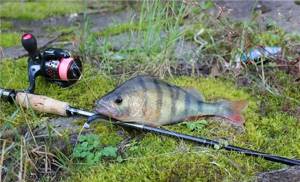
Experts and athletes recommend using a stick, the length of which is between 2.4-3.2 meters, when fishing from the shore. But the choice of length, as already mentioned, depends on the coastal landscape.
When choosing a spinning rod for perch from a boat, you should give preference to a spinning rod with a length of 1.8-2.1 meters. It is believed that longer structures can be used in open water, although this does not happen so often.
In both cases, the spinner performs many casts. At the end of the rest, out of habit, my hands hurt and my back ache. Therefore, you need to think several times about which rod to take for fishing.
Coil
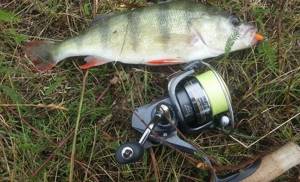
As mentioned earlier, the average size of a striped predator ranges from 300 to 500 grams. Consequently, a powerful and heavy coil will not justify itself; there is no point in installing it. It is advisable to use thin fishing line on a 1 thousand spool. It will hold 100 meters of fishing line with a diameter of 0.1 mm. This is quite enough for fishing from the shore or boat. The average casting length of a 10 gram bait is 30 meters.
fishing line
There are two options in this matter:
- Use fishing line.
- Or a braided one.
There is no consensus on this issue. Some prefer fishing line, others prefer cord. Many people tend to believe that a fishing line with a diameter of 0.18 mm is the best option. She copes with the obstinate minke whale and easily removes it from the water. A fishing line of this diameter combines with a spinning rod of medium or slow action: the shock absorption of the rod works.
As for the braided line. It has exactly the same breaking load as mono/filament. A cord with a diameter of 0.1-0.12 mm has the same strength as the monofilament version. Monofilament with a diameter of 0.25-0.30 mm, with a break of 2.5 kg, is also an option. Experienced fishermen prefer braided line, knowing that next to the perch there may be a toothy pike that can instantly bite through the fishing line.
What else to pay attention to
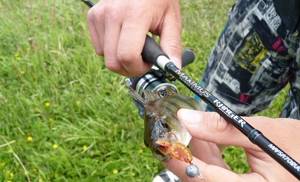
It is also important what material the spinning rod’s whip and handle are made of. You can safely take a rod made of fiberglass. In addition, their cost will not scare a beginner. The main thing is the form: what it is made of and what quality it is. In specialized stores there are products:
- Made from carbon.
- And composite materials.
They have decent quality characteristics. One catch is the price. Let's focus on the rod handle. It is made: From corrugated plastic. This is a budget option.
- Neoprene option.
- Cork version.
The choice of handle is the prerogative of the fisherman. It's nice to feel a good quality handle. Although, this is not important to the perch. A hungry predator does not pay attention to the flaws in the beginner’s wiring and attacks the bait.
Lures for catching perch using a spinning rod
- wobblers
- spinners
- oscillating spoon
- silicone baits
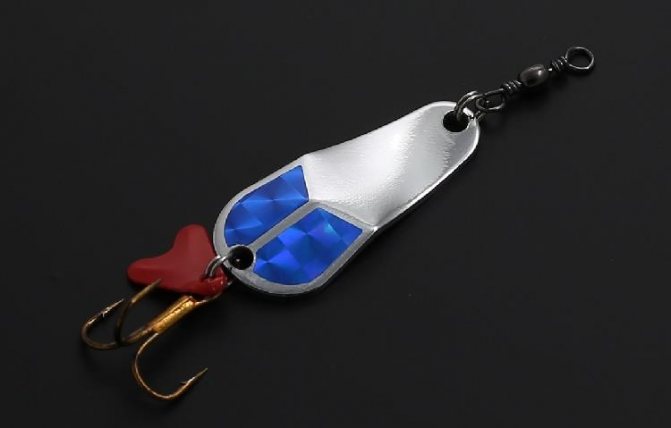
Selecting a spinning rod (video)
Also read our interesting articles on the topic of spinning:
- The best budget spinning rods
- Budget reels for spinning rods
- Budget reels for ultralight spinning rods
- Spinning equipment
- What materials are fishing rods made of?
- About offset hooks
- Floating silicone baits
- DIY silicone baits at home
- A selection of articles about spinning gear
Author of the article: Vitaly Leonidovich Ivanov, 2021.
Rating of spinning rods for perch
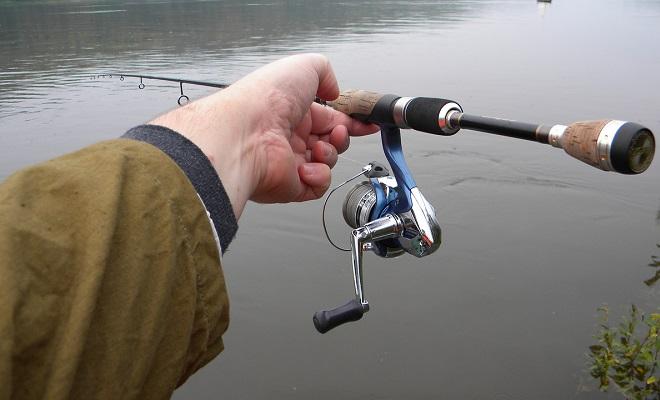
It would be surprising to ignore popular models of spinning rods.
Zebco Topic Tele Star
The telescope is made of composite material. The cost is reasonable. It’s good because it doesn’t take up much space if you’re traveling on foot to the fishing spot. Performance indicators 240 mm length. When folded, it is 64 cm. The weight of the stick is 186 grams. Test: 8-23 gr.
Maximus Legend-X 18UL
A powerful, sensitive universal rod with a fast action. It performs well when working with wobblers, small spinners and jig baits.
Kosadaka Lighting 210 UL
A rod of good quality, middle class, with good sensitivity. They can safely catch medium-sized perch on a jig.
Daiwa Morethan Branzino 87LML
Pay attention to the expensive plug, 261 cm long. Test 3-15 grams. The weight of the product is only 122 g.
Volzhanka
Among the domestic developments, we can highlight the tackle for catching perch: Volzhanka Lux 2-7. This is a mid-range spinning rod. Shows itself well in working with small-sized spinners. The difference is high sensitivity.
How to choose a good spinning rod for perch fishing?
Since the size of the striped predator in most reservoirs of our country leaves much to be desired, a light and sensitive stick is required for targeted perch fishing. When choosing a spinning rod for perch fishing, pay attention to the following parameters:
- Construction . On sale you can find one-piece fishing rods, telescopes and plug-in models. Solid fishing rods have better balance and the highest sensitivity, but due to their long length they can only be used by fishermen who live on the shore of a reservoir. Telescopes are very easy to transport; they can even be hidden in a backpack or travel bag. But in terms of sensitivity and reliability, they leave much to be desired. The optimal option for most spinning anglers remains a two-piece plug-type rod, which ideally combines all the most important characteristics of a spinning rod.
- Length . The next parameter that will narrow down the search for the best spinning rod for catching perch is length. It is determined by the fishing method. If you have a boat, you can limit yourself to a length of 2.1 m. To fish distant waters from the shore, a stick of 2.4-3.0 m is required. You also need to take into account the wiring technique. So, for twitching wobblers, shorter models are chosen than for jigs.
- Test . The manufacturer indicates the weight range of the baits used in the form of a test. Indirectly, this indicator indicates the strength of the fishing rod. The lightest models (0.5-10 g) are designed for fishing for perch at shallow depths in the absence of current. If the striped robber hunts on the riverbed edges of large rivers, then the test load of the spinning rod can reach 50 g.
- Build . Depending on how the rod blank bends under load (action), its range and sensitivity depend. If the choice fell on a fast wand, then you should not expect accuracy and range from it. But it will transmit the bite perfectly. Medium action blanks are used for long-distance fishing. They are suitable for catching predators in “cauldrons” that form far from the shore.
Our review includes the 5 best spinning rods for perch fishing. All fishing rods were selected taking into account the opinions of sports fishermen and reviews of outdoor enthusiasts.
